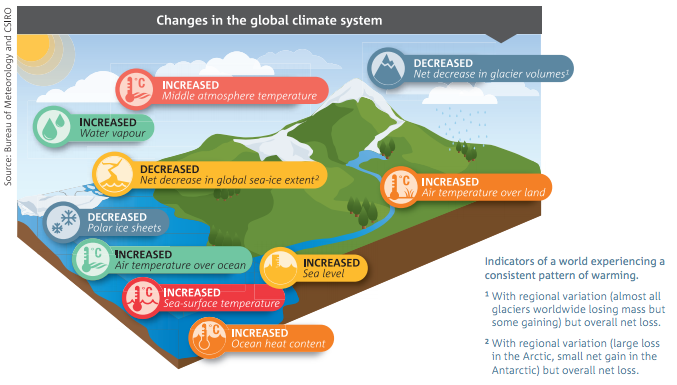AusSMC: CSIRO and the Bureau of Meteorology have released their latest “State of the Climate” report on observed changes in long term trends in Australia’s climate. The report, which is released once every two years, looks at trends in temperature, rainfall, heatwaves and fire weather, ice and snow, oceans and greenhouse gases and also examines future climate scenarios for Australia. Below Australian experts respond.
COMMENTS FROM BOM/CSIRO
Dr Rob Vertessy, Chief Executive of the Bureau of Meteorology, comments:
“Australia’s mean temperature has warmed by 0.9°C since 1910. Seven of the ten warmest years on record in Australia have occurred since 1998. When we compare the past 15 years to the period 1951 to1980, we find that the frequency of very warm months has increased five-fold and the frequency of very cool months has decreased by around a third.
“The duration, frequency and intensity of heatwaves have increased across large parts of Australia since 1950. Extreme fire weather risk has increased, and the fire season has lengthened across large parts of Australia since the 1970s.”
“We have also seen a general trend of declining autumn and winter rainfall, particularly in southwestern and southeastern Australia, while heavy rainfall events are projected to increase. Australian average annual rainfall has increased slightly, largely due to increases in spring and summer rainfall, most markedly in northwestern Australia.”
Dr Megan Clark, Chief Executive of CSIRO, comments:
“Australia has one of the most variable climates in the world. Against this backdrop, across the decades, we’re continuing to see increasing temperatures, warmer oceans, changes to when and where rain falls and higher sea levels.”
“The sea-surface temperatures have warmed by 0.9°C since 1900 and greenhouse gas concentrations continue to rise.”
INDEPENDENT EXPERT COMMENTS:
Dr Jim Salinger, climate scientist and Honorary Research Associate at the University of Auckland comments:
“This shows that Australia continues to be the burning, drying continent. The duration and intensity of heatwaves and days above 40°C continues to increase. Temperatures aee projected to increase with more hot days and fewer cold days. The report shows that there has been an increase an increase in extreme fire weather across large parts of the continent since 1970. Further increases in extreme fire weather days is expected in the south east, with a longer fire season. With continued drying in parts of the southern half of Australia, droughts are projected to increase. With such trends I would expect to see a reverse in migration across the Tasman, with increasing numbers of Australians coming to New Zealand. This is as the climate of continental Australia becomes very harsh.”
Professor Neville Nicholls, School of Geography & Environmental Science at Monash University, comments:
“Severe heat events are becoming more frequent and the climate drivers of bushfire activity are intensifying. Heat events and bushfires already cause deaths and illness, infrastructure damage, and property destruction. But recent climate change has exacerbated the risks.
“Luckily, we have started to adapt to these risks. Heat alert systems in many cities across the world, including Australia, are starting to reduce some of the impacts of severe heat events. And governments, fire services, and bureaucrats have worked to improve the way we prepare for and deal with bushfires; this is an effective climate change adaptation, even if it was not done specifically in response to the climate-driven increased risk.
“Heatwaves and bushfires still kill too many people, and cause too much damage and dislocation. But the heatwave alerts and other adaptations are offsetting some of the climate-driven risk increases. Nevertheless, we need to intensify our adaptation efforts because heatwaves and the risks of bushfires will likely continue to increase in frequency and severity. This adaptation would be simpler if politicians could slow the growth in emissions of the greenhouse gases that is the underlying cause of the increased risks of heat waves and bush fires.”
Dr Sarah Perkins, Research Associate at the ARC Centre of Excellence for Climate System Science at the University of New South Wales, comments:
“The Australian 2014 State of the Climate report is consistent with the overwhelming amount of climate science literature. The global land surface has warmed, and this includes Australia. The report indicates that Australian average temperatures have warmed by 0.9C since 1910, at almost exactly the same rate of global temperatures (0.85C since 1910).
“Our regional warming is consistent with the amount of warming our surrounding oceans have experienced. Moreover, most of this warming has occurred since the 1950s, consistent with the latest IPCC Working Group I report, released in late 2013. Indeed, for Australia, seven of our ten warmest years on record have occurred since 1998, including our warmest year on record in 2013.
“Increases in average temperatures infer increases in extreme temperatures, and this report confirms this for both maximum and minimum temperatures – both are getting warmer. The number of extremely hot days has outnumbered extremely cold days, 3 to 1. Increases in the intensity, frequency and duration of heatwaves, as well as longer fire seasons, have occurred particularly for southern and eastern Australia.
“Conditions of heat and fire over the past two summers pretty much sum up what we have seen over the longer term. Future projections only continue these trends, towards hotter and longer heatwaves, more often, and longer fires seasons. Although we are not necessarily locked in to projections for the end of the century, we are in the shorter term, and so adaptation and mitigation procedures are imperative.”
